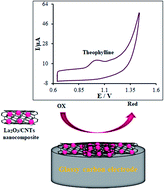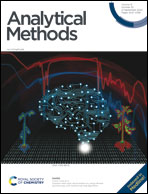Synthesis of La2O3/MWCNT nanocomposite as the sensing element for electrochemical determination of theophylline†
Abstract
In this study, an electrochemical sensor was applied for the determination of theophylline, a bronchodilator drug, using differential pulse voltammetry (DPV). A glassy carbon electrode (GCE) surface was modified with the La2O3/MWCNT nanocomposite. The design is simplistic, efficient, greener and solvent-free microwave procedure for synthesizing La2O3/MWCNT nanocomposites. Fourier transform infrared (FT-IR) spectroscopy, field emission scanning electron microscopy (FESEM), energy dispersive X-ray spectroscopy (EDX), and X-ray diffraction (XRD) techniques are used to characterize the features of the La2O3/MWCNT nanocomposite morphology and structure. The use of the modified sensor remarkably enhanced the current density and displayed a linear response ranging between 0.1 and 400.0 μM, with a limit of detection of 0.01 μM (S/N = 3). Using optimized conditions, the modified sensor demonstrated very good stability, selectivity and improved accuracy. Acceptable outputs were achieved in the analysis of real specimens, indicating that it is possible to use the modified sensor for practical analyses.



 Please wait while we load your content...
Please wait while we load your content...